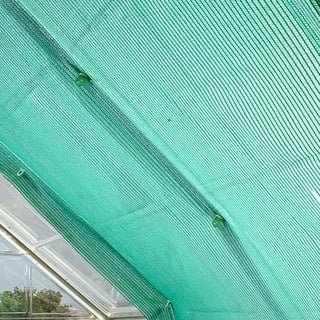Shading your greenhouse
Written by John Harrison on 8th May 2015.
Greenhouses serve to both extend the growing season and to provide better growing conditions during the season, enabling us grow tender crops such as tomatoes and aubergines even in a bad summer.
In a good summer though the greenhouse can become a very hostile climate to grow in. It's surprising how quickly the temperature can soar to levels that kill our plants as surely as if they were put in the oven. That same sunlight that powers photosynthesis and growth can turn to scorching, killing the leaves.
Ideal Greenhouse Temperature
The ideal temperature for a greenhouse is lower than you may have expected; between 20 and 24 degrees C. Temperatures above 27 degrees C should be avoided.
Good ventilation is critical to maintaining temperatures in the best range for growing. Automatic vent openers are really useful because it's always the day you're away or the morning you sleep in that the sun decides to over-heat the greenhouse. The automatic openers can save the day.
Summer Greenhouse Shading

When we do get a reasonable summer in Britain, which happens more than you might think, opening the vents will not be enough and we turn to shading the house. There are different ways to shade your greenhouse and all have their good points and bad.
Because all shading works by reflecting sunlight or preventing sunlight from reaching the plants and greenhouse base, there is less light and energy available to power photosynthesis.
Greenhouse Shading Paints
Whitewashing the outside of the greenhouse or potting shed will reflect sunlight and, therefore, prevent or at least reduce overheating and prevent the sun from scorching your crops. The most popular product for this is Cool Glass from Bayer.
It's fairly cheap to buy but it takes time to apply and it can be difficult to safely apply to the roof, especially with larger houses. The same applies at the end of the summer when it comes to removing the shade paint which is brushed and rubbed off.
Cool Glass does have a useful feature in that it becomes clear when wet so in rainy weather it allows all the available light through. As it dries it becomes reflective again.
Greenhouse Blinds & Net Shading

The cheap and cheerful solution, often seen on allotments, is to use green shade netting or even old net curtains draped over the greenhouse and tied in place with string. It doesn't look very pretty but it does the job.Care has to be taken that the netting does not obstruct vents, especially automatically opening roof vents, which would be counter-productive. Unless tied properly, they have a habit of blowing out of position or even completely off the house in even moderate winds.
Purpose Made Greenhouse Blinds
Purpose made external blinds that are drawn down or across the house are far easier to draw up in dull weather and down again in sunny providing much better control. They tend to be a fairly costly option but not so bad when that cost is apportioned over the life of the greenhouse.
Internal blinds tend to be cheaper but, as the sunlight has already come through the glass, less good at cooling the house than external blinds. The do have a benefit in that they provide some insulation value and keep heat in the greenhouse overnight.
Copyright © John Harrison 2014